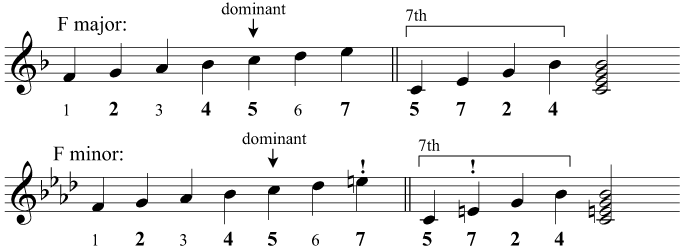The dominant 7th
In this guide...
Key terms:
Subscription required!
To view the complete study guide, you will need a valid subscription. Why not subscribe now?
Already have a subscription? Make sure you login first!
Introduction
It's now time to meet a very important chord, and the first that you've met which has more than three notes.
A reminder
Remember that triads are harmonies made of three notes built up in thirds: root, third, and fifth, and they can be begun on any degree of the scale, such as the tonic (to make I), the subdominant (to make IV) or the dominant (to make V).
Here is a very brief reminder in E major:
 A reminder of the primary triads in E major
A reminder of the primary triads in E majorWe can extend this principle of adding thirds - after the root, third, and fifth - to make further chords. If we add one more third on top of a normal triad we get a seventh chord: a chord with a seventh above its root.
The dominant 7th chord
Although there are many possibilities for seventh chords, the seventh chord built on the dominant degree of the scale is the most common and the most important.
This chord is is frequently used instead of a standard V in perfect cadences and is called the dominant seventh chord.
 Constructing a dominant seventh chord in E major
Constructing a dominant seventh chord in E majorIn minor keys
As you should remember from Functions of harmony:
The dominant triad is a major triad in a minor key!
This is because the harmonic minor scale has a raised 7th degree, which in turn means that the third of the dominant triad is raised, making the dominant triad a major not a minor triad.
The same is true of the dominant seventh chord: it has exactly the same notes whether it is in a major key or a minor key. The example below shows the same dominant seventh chord resolving to I in F major, and then in F minor.
 The dominant seventh chord is identical in F major and F minor
The dominant seventh chord is identical in F major and F minorTriads or chords?
It should be noted that we are no longer discussing triads, because triads have three notes only (just as a tricycle has three wheels and a trio consists of three people!)
A seventh chord is a modified triad, with four notes, and therefore result is just type of chord, and no longer a triad.
Alternative names
In the alternative system of naming chords, in which G represents a chord or triad of G major (G, B, and D), we simply add a "7" to the chord to which a seventh has been added, so G7 would mean the notes G, B, D, and F. This chord G7 is the dominant seventh chord in C major.
This shows up one important difference with that system: when you see G7 alone you have no way of knowing that it's a dominant seventh or just another seventh chord, unless you know the key. However, if you play the guitar for example, and you know the fingering for G7, it's much more helpful to read "G7" than "dominant seventh in C major"!
Roman numerals
In the Roman numeral system, in which V indicates the dominant triad, we simply add a "7" to indicate a dominant seventh: V7. Unlike the "G7" system, this will of course work in any key.
Inversions
Just as with the triads, the dominant 7th chord can appear in different inversions, depending on which note is in the bass:
- The root is in the bass: root position
- The third is in the bass: first inversion
- The fifth is in the bass: second inversion
We can use exactly the same system with Roman numerals to indicate the inversion: V7a, V7b, V7c.
Here are the root, first, and second inversions of the dominant seventh chord in E major:
 The dominant seventh chord in E major, root position, first and second inversions
The dominant seventh chord in E major, root position, first and second inversionsResolving
One interesting aspect of the dominant seventh is that, when heard, it strongly seems to want to resolve to the tonic chord. By "resolve" we mean that the dominant seventh chord sounds unstable, and if you follow it with a tonic chord, this will produce a very stabilising effect. The example below shows dominant seventh chords resolving to tonic chords in several keys.
 Resolving dominant seventh chords in several keys
Resolving dominant seventh chords in several keysThis example shows a couple of small but significant points:
- The dominant seventh chord does not necessarily have to include all four notes. The essential notes are the root and the 7th, after which either (or both) of the 3rd and the 5th are sufficient to make the chord a "dominant seventh chord" (as in the examples in C major and G sharp minor).
- The 7th itself should always resolve down by a semitone to the 3rd of the tonic chord. Try and find the 7th in each of the
V7chords shown above, and look at how they resolve down to the 3rd of the tonic (I) chord.
Read more...
With a subscription to Clements Theory you'll be able to read this and dozens of other study guides, along with thousands of practice questions and more! Why not subscribe now?